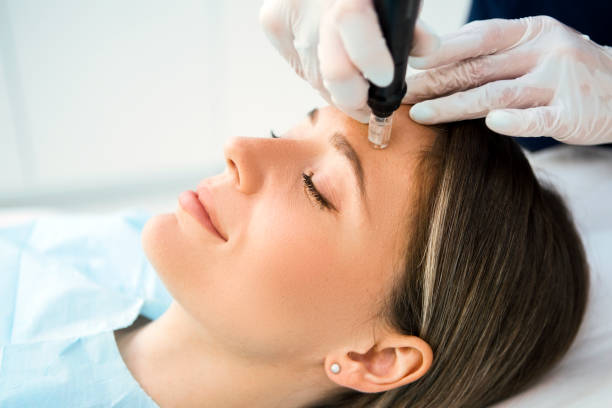Derma Roller Treatment - Abu Dhabi - Dubai
Derma rolling, also known as microneedling or collagen induction therapy, is a cosmetic procedure that involves using a small handheld device called a derma roller. The derma roller consists of numerous tiny needles on a roller that is rolled over the skin's surface.
The procedure is typically performed in a dermatologist's office or by a trained professional, but there are also at-home derma rollers available for personal use. Here's how the treatment generally works:
- 1. Cleansing: The skin is thoroughly cleansed to remove any dirt, oil, or makeup.
- 2. Numbing (optional): Some clinics may apply a topical anesthetic to the treatment area to minimize discomfort. At-home derma rollers typically don't require numbing.
- 3. Preparation: The derma roller is sterilized, and the treatment area is prepared with an antiseptic solution to minimize the risk of infection.
- 4. Rolling: The derma roller is gently rolled over the skin in different directions, creating tiny punctures or microchannels. The depth of the needles can vary depending on the desired results and the condition being treated.
- 5. Application (optional): Depending on the purpose of the treatment, a serum, cream, or other topical product may be applied immediately after rolling. This is done to enhance the absorption of the product into the deeper layers of the skin.
The micro-injuries created by the derma roller stimulate the body's natural wound healing response, triggering the production of collagen and elastin. These proteins are essential for maintaining the skin's strength, elasticity, and youthful appearance.
Derma rollers are commonly used for the following purposes:
- 1. Improving skin texture: Microneedling can help reduce the appearance of fine lines, wrinkles, and acne scars, promoting smoother and more even skin texture.
- 2. Enhancing skin tone: The procedure may help improve skin pigmentation issues, such as sunspots, age spots, and melasma, leading to a more even skin tone.
- 3. Treating stretch marks: Derma rolling can be used to reduce the appearance of stretch marks by stimulating collagen production in the affected areas.
- 4. Boosting product absorption: The microchannels created by the derma roller allow for better absorption of topical products, maximizing their effectiveness.
It's important to note that while derma rolling can be an effective treatment, it should be performed by a trained professional to ensure safety and optimal results. At-home derma rollers should be used with caution and following the provided instructions.
After the treatment, you may experience some redness, swelling, and mild discomfort, similar to a sunburn. These side effects usually subside within a few days. It's crucial to follow the aftercare instructions provided by your dermatologist or the manufacturer of the derma roller.
It's also essential to protect your skin from sun exposure and use a broad-spectrum sunscreen after the procedure, as the skin becomes more sensitive to UV damage. Avoid applying makeup or any potentially irritating products immediately after the treatment.
It's recommended to consult with a dermatologist or a skincare professional to determine if derma rolling is suitable for your specific concerns and to ensure proper guidance throughout the treatment process.

